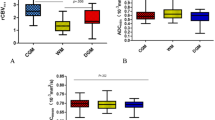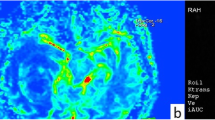Abstract
Objectives
To test if adding permeability measurement to perfusion obtained from dynamic susceptibility contrast MRI (DSC-MRI) improves diagnostic performance in the differentiation of primary central nervous system lymphoma (PCNSL) from glioblastoma.
Materials and methods
DSC-MRI was acquired in 145 patients with pathologically proven glioblastoma (n = 89) or PCNSL (n = 56). The permeability metrics of contrast agent extraction fraction (Ex), apparent permeability (Ka), and leakage-corrected perfusion of normalized cerebral blood volume (nCBVres) and cerebral blood flow (nCBFres) were derived from a tissue residue function. For comparison purposes, the leakage-corrected normalized CBV (nCBV) and relative permeability constant (K2) were also obtained using the established Weisskoff-Boxerman leakage correction method. The area under the receiver operating characteristics curve (AUC) and cross-validation were used to compare the diagnostic performance of the single DSC-MRI parameters with the performance obtained with the addition of permeability metrics.
Results
PCNSL demonstrated significantly higher permeability (Ex, p < .001) and lower perfusion (nCBVres, nCBFres, and nCBV, all p < .001) than glioblastoma. The combination of Ex and nCBVres showed the highest performance (AUC, 0.96; 95% confidence interval, 0.92–0.99) for differentiating PCNSL from glioblastoma, which was a significant improvement over the single perfusion (nCBV: AUC, 0.84; nCBVres: AUC, 0.84; nCBFres: AUC, 0.82; all p < .001) or Ex (AUC, 0.80; p < .001) parameters.
Conclusions
Analysis of the combined permeability and perfusion metrics obtained from a single DSC-MRI acquisition improves the diagnostic value for differentiating PCNSL from glioblastoma in comparison with single-parameter nCBV analysis.
Key Points
• Permeability measurement can be calculated from DSC-MRI with a tissue residue function-based leakage correction.
• Adding Exto CBV aids in the differentiation of PCNSL from glioblastoma.
• CBV and Exmeasurements from DSC-MRI were highly reproducible.




Similar content being viewed by others
Abbreviations
- AUC:
-
Area under the receiver operating characteristics curve
- DCE:
-
Dynamic contrast-enhanced
- DSC:
-
Dynamic susceptibility contrast
- E x :
-
Extraction fraction
- K 2 :
-
Relative permeability constant
- K a :
-
Apparent permeability
- K trans :
-
Contrast agent transfer constant
- nCBFres :
-
Leakage-corrected normalized cerebral blood flow from a tissue residue function-based method
- nCBV:
-
Normalized cerebral blood volume from a Weisskoff-Boxerman method
- nCBVres :
-
Leakage-corrected normalized cerebral blood volume from a tissue residue function-based method
References
Thompson G, Mills S, Coope D, O’connor J, Jackson A (2011) Imaging biomarkers of angiogenesis and the microvascular environment in cerebral tumours. Br J Radiol 84:S127–S144
Koeller KK, Smirniotopoulos JG, Jones RV (1997) Primary central nervous system lymphoma: radiologic-pathologic correlation. Radiographics 17:1497–1526
Hartmann M, Heiland S, Harting I et al (2003) Distinguishing of primary cerebral lymphoma from high-grade glioma with perfusion-weighted magnetic resonance imaging. Neurosci Lett 338:119–122
Liao W, Liu Y, Wang X et al (2009) Differentiation of primary central nervous system lymphoma and high-grade glioma with dynamic susceptibility contrast-enhanced perfusion magnetic resonance imaging. Acta Radiol 50:217–225
Xu W, Wang Q, Shao A, Xu B, Zhang J (2017) The performance of MR perfusion-weighted imaging for the differentiation of high-grade glioma from primary central nervous system lymphoma: a systematic review and meta-analysis. PLoS One 12:e0173430
Kickingereder P, Sahm F, Wiestler B et al (2014) Evaluation of microvascular permeability with dynamic contrast-enhanced MRI for the differentiation of primary CNS lymphoma and glioblastoma: radiologic-pathologic correlation. AJNR Am J Neuroradiol 35:1503–1508
Zhao J, Yang ZY, Luo BN, Yang JY, Chu JP (2015) Quantitative evaluation of diffusion and dynamic contrast-enhanced MR in tumor parenchyma and peritumoral area for distinction of brain tumors. PLoS One 10:e0138573
Nguyen TB, Cron GO, Mercier JF et al (2012) Diagnostic accuracy of dynamic contrast-enhanced MR imaging using a phase-derived vascular input function in the preoperative grading of gliomas. Am J Neuroradiol 33:1539–1545
Bjornerud A, Sorensen AG, Mouridsen K, Emblem KE (2011) T1- and T2*-dominant extravasation correction in DSC-MRI: part I--theoretical considerations and implications for assessment of tumor hemodynamic properties. J Cereb Blood Flow Metab 31:2041–2053
Paulson ES, Schmainda KM (2008) Comparison of dynamic susceptibility-weighted contrast-enhanced MR methods: recommendations for measuring relative cerebral blood volume in brain tumors. Radiology 249:601–613
Weisskoff R, Boxerman J, Sorensen A, Kulke S, Campbell T, Rosen B (1994) Simultaneous blood volume and permeability mapping using a single Gd-based contrast injection. Proceedings of the Society of Magnetic Resonance, Second Annual Meeting, San Francisco, Calif. Berkeley, pp p.279
Louis DN, Perry A, Reifenberger G et al (2016) The 2016 World Health Organization classification of tumors of the central nervous system: a summary. Acta Neuropathol 131:803–820
Bjornerud A, Kleppesto M, Batchelor TT, Wen P, Sorensen AG, Emblem KE (2016) Test-retest stability of MTT insensitive CBV leakage correction in DSC-MRI Proceedings of the 24th Annual Meeting of International Society of Magnetic Resonance in Medicine (ISMRM), Singapore, Singapore
Boxerman JL, Schmainda KM, Weisskoff RM (2006) Relative cerebral blood volume maps corrected for contrast agent extravasation significantly correlate with glioma tumor grade, whereas uncorrected maps do not. AJNR Am J Neuroradiol 27:859–867
Sourbron S, Ingrisch M, Siefert A, Reiser M, Herrmann K (2009) Quantification of cerebral blood flow, cerebral blood volume, and blood-brain-barrier leakage with DCE-MRI. Magn Reson Med 62:205–217
Ostergaard L, Weisskoff RM, Chesler DA, Gyldensted C, Rosen BR (1996) High resolution measurement of cerebral blood flow using intravascular tracer bolus passages. Part I: mathematical approach and statistical analysis. Magn Reson Med 36:715–725
Emblem KE, Bjornerud A (2009) An automatic procedure for normalization of cerebral blood volume maps in dynamic susceptibility contrast-based glioma imaging. AJNR Am J Neuroradiol 30:1929–1932
DeLong ER, DeLong DM, Clarke-Pearson DL (1988) Comparing the areas under two or more correlated receiver operating characteristic curves: a nonparametric approach. Biometrics 44:837–845
Jain R (2011) Perfusion CT imaging of brain tumors: an overview. AJNR Am J Neuroradiol 32:1570–1577
Molnar PP, O'Neill BP, Scheithauer BW, Groothuis DR (1999) The blood-brain barrier in primary CNS lymphomas: ultrastructural evidence of endothelial cell death. Neuro Oncol 1:89–100
Larsson HB, Courivaud F, Rostrup E, Hansen AE (2009) Measurement of brain perfusion, blood volume, and blood-brain barrier permeability, using dynamic contrast-enhanced T(1)-weighted MRI at 3 tesla. Magn Reson Med 62:1270–1281
Sorensen AG, Batchelor TT, Zhang WT et al (2009) A “vascular normalization index” as potential mechanistic biomarker to predict survival after a single dose of cediranib in recurrent glioblastoma patients. Cancer Res 69:5296–5300
Alger JR, Schaewe TJ, Lai TC et al (2009) Contrast agent dose effects in cerebral dynamic susceptibility contrast magnetic resonance perfusion imaging. J Magn Reson Imaging 29:52–64
Liu HL, Wu YY, Yang WS, Chen CF, Lim KE, Hsu YY (2011) Is Weisskoff model valid for the correction of contrast agent extravasation with combined T1 and T2* effects in dynamic susceptibility contrast MRI? Med Phys 38:802–809
Emblem KE, Bjornerud A, Mouridsen K et al (2011) T1- and T2*-dominant extravasation correction in DSC-MRI: Part II— predicting patient outcome after a single dose of cediranib in recurrent glioblastoma patients J Cereb Blood Flow Metab 31:2054–2064
Grovik E, Redalen KR, Storas TH et al (2017) Dynamic multi-echo DCE- and DSC-MRI in rectal cancer: Low primary tumor Ktrans and ΔR2* peak are significantly associated with lymph node metastasis. J Magn Reson Imaging 46:194–206
Funding
This research was supported by the National Research Foundation of Korea (NRF) Grant by the Korean government (MSIP) (grant nos. NRF-2017R1A2A2A05001217 and NRF-2017R1C1B2007258).
Author information
Authors and Affiliations
Corresponding author
Ethics declarations
Guarantor
The scientific guarantor of this publication is Ho Sung Kim.
Conflict of interest
The authors of this manuscript declare no relationships with any companies, whose products or services may be related to the subject matter of the article.
Statistics and biometry
No complex statistical methods were necessary for this paper.
Informed consent
Written informed consent was waived by the Institutional Review Board.
Ethical approval
Institutional Review Board approval was obtained.
Methodology
• retrospective
• cross-sectional study
• performed at one institution
Additional information
Publisher’s note
Springer Nature remains neutral with regard to jurisdictional claims in published maps and institutional affiliations.
Electronic supplementary material
ESM 1
(DOCX 19 kb)
Rights and permissions
About this article
Cite this article
Lee, J.Y., Bjørnerud, A., Park, J.E. et al. Permeability measurement using dynamic susceptibility contrast magnetic resonance imaging enhances differential diagnosis of primary central nervous system lymphoma from glioblastoma. Eur Radiol 29, 5539–5548 (2019). https://doi.org/10.1007/s00330-019-06097-9
Received:
Revised:
Accepted:
Published:
Issue Date:
DOI: https://doi.org/10.1007/s00330-019-06097-9




